![]()
![]()
![]()
Use LEFT and RIGHT arrow keys to navigate between flashcards;
Use UP and DOWN arrow keys to flip the card;
H to show hint;
A reads text to speech;
36 Cards in this Set
- Front
- Back
|
What are the most common cancers in men and women, and where are breast cancers typically found?
|
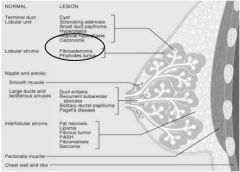
Men - Prostate, lung, colorectal
Women - Breast, lung, colorectal Carcinoma are typically found in terminal ducts or lobular units Fibroadenomas in the lobular stroma Sarcomas and lipomas in the interlobular stroma |
|
|
What are the distinctive features of a fibroadenoma?
|
Discrete, rounded, firm and smooth
|
|
|
What is the current UK policy on mammography?
|
Women between 50-70 years old offered screening every 3 years
|
|
|
Describe the anatomical position of the breast and areolus and the muscles they overlie. Also explain the 'milk line'.
|
No more medial than the lateral border of the sternum
The tail extands towards the axilla but goes no further than the mid-axillary line Superiorly 2nd rib Inferiorly 6th rib Areolus between 4th and 5th ribs Top 2/3rds over Pec Major Bottom 1/3 over Serratus Anterior Milk line runs from axilla to groin and is the site for polymastia (extra boobs) and polythelia (extra nips) |
|
|
What is the axillary tail of Spence?
|
Line of glandular tissue entending up towards the axilla, piercing pec major, and passing through a hole in the deep fascia called 'Langer's Foramen'
|
|
|
What are Montgomery's tubercles?
|
Small sebaceous glands around the areolus secreting an oily substance to keep the nipple moist in suckling.
|
|
|
Give an account of the innervation of the breast, and describe the factors involved in lactation, ejection and erection of the nipple.
|
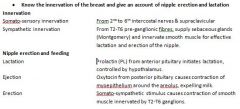
|
|
|
Describe the lymphatic drainage of the breast and the likely nodes involved in the spread of metastases.
|

|
|
|
Describe the histological changes apparent in the acini and duct system and classify the secretion of milk as apocrine, merocrine or holocrine?
|

Milk is an apocrine secretion (modified sweat gland)
Apocrine = Cell releases contents into lumen surrounded by membrane |
|
|
There are 199 different cell types in the body, what are the 3 main classifications?
|

|
|

Describe the phases of the cell cycle and give their lengths.
|

Cyclins control the progression of cells through the cell cycle by activating cyclin-dependent kinase (Cdk) enzymes
|
|
|
Describe the system of checks contained within the cell cycle.
|
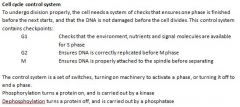
|
|
|
Describe the four factors which maintain cells in a 'steady state'
|

|
|
|
Excessive external strains and stimuli upset the cell 'steady state' and cause adaptive changes. List the four types and briefly describe them.
|
Hyperplasia - Increase in cell number. Can be physiological, e.g. growth of breast in puberty, or pathological, e.g. tumour driving excess hormonal growth
Hypertrophy - Adaptive response of increased mass (not number) to maintain viability at higher levels of metabolic activity Metaplasia - Reversible change in which one adult cell type replaces another Dysplasia - Morphological features of malignancy such as increased proliferation and incomplete differentiation even before surrounding tissue is invaded |
|
|
Explain metaplasia and give three examples
|

|
|
|
Define and explain dysplasia
|

|
|
|
Explain the components of a basic tumour.
|

|
|
|
Give the 5 mechanisms by which malignant cancers invade
|

|
|
|
Give the four ways to differentiate benign from malignant growths
|

|
|
|
Define Anaplasia and explain how this phenomena is used to distinguish malignancy
|
Anaplasia = to form backwards
Explains the tendency of malignant cells to 'dedifferentiate' back to an abnormal state Applies to parenchymal cells (functional, not structural) Malignant cells are typically poorly differentiated, unlike their non-malignant neighbours Differentiation takes time, so malignant cells can grow quicker than benign growths which are slow due to their differentiation |
|
|
What are the two major criteria for diagnosis of cancer in it's primary site of origin?
|
Anaplasia and evidence of invasion of surrounding tissues
|
|
|
List the five factors which epidemiology looks at, and explain the concepts of tumour incidence, prevalence and mortality
|

|
|
|
Give the positive risk factors for breast cancer?
|

|
|
|
Define positive predictive value, negative predictive value, specificity, sensitivity and likelihood ratios.
|
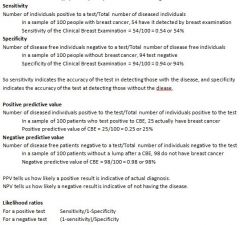
|
|
|
Describe the 4 routes by which cancers disseminate.
|

|
|
|
Explain the essential steps in metastasis formation
|

|
|
|
What are the local and systemic effects of cancer on the host?
|
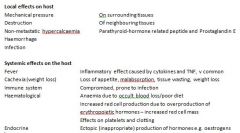
|
|
|
Explain Knudson and Vogelsteins theories of cancer development.
|

|
|
|
How do normal cells become neoplasms?
|
Telomerase
Tunour suppressor genes Oncogenes |
|
|
Give examples of tumour suppressor genes and the cancers they will cause.
|
Gatekeepers - inhibit proliferation: Rb1 - Retinoblastoma, APC - Familial Adenomatous Polyposis
Caretakers - repair DNA and promote apoptosis of damaged cells: P53 (Li Fraumeni), BRCA1/2 |
|
|
Give examples of some oncogenes
|
Ras - Intracellular signalling
Abl - Protein tyrosine kinase c-myc - Accelerates cell proliferation erB - Epidermal growth factor |
|
|
How does radiation cause cancer?
|
Increases tissue turnover, and causes breaks in DNA strands
|
|
|
What is Herceptin and which cancers is it useful for?
|

|
|
|
What is tamoxifen?
|

|
|
|
How does staging affect survival?
|
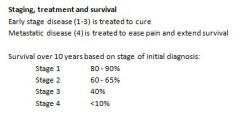
|
|
|
Give some examples of cancer risk factors which can and cannot be controlled
|
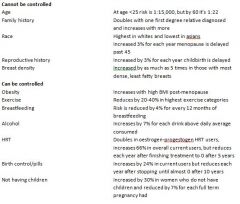
|

